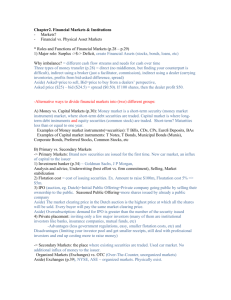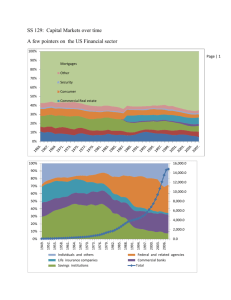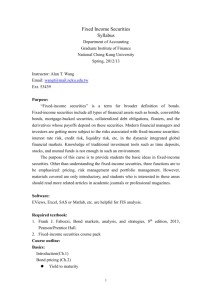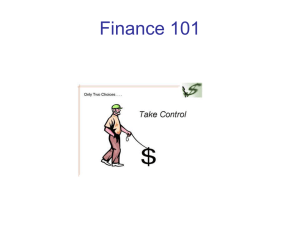Chapter 2: Financial Institutions and Markets - Rose
advertisement
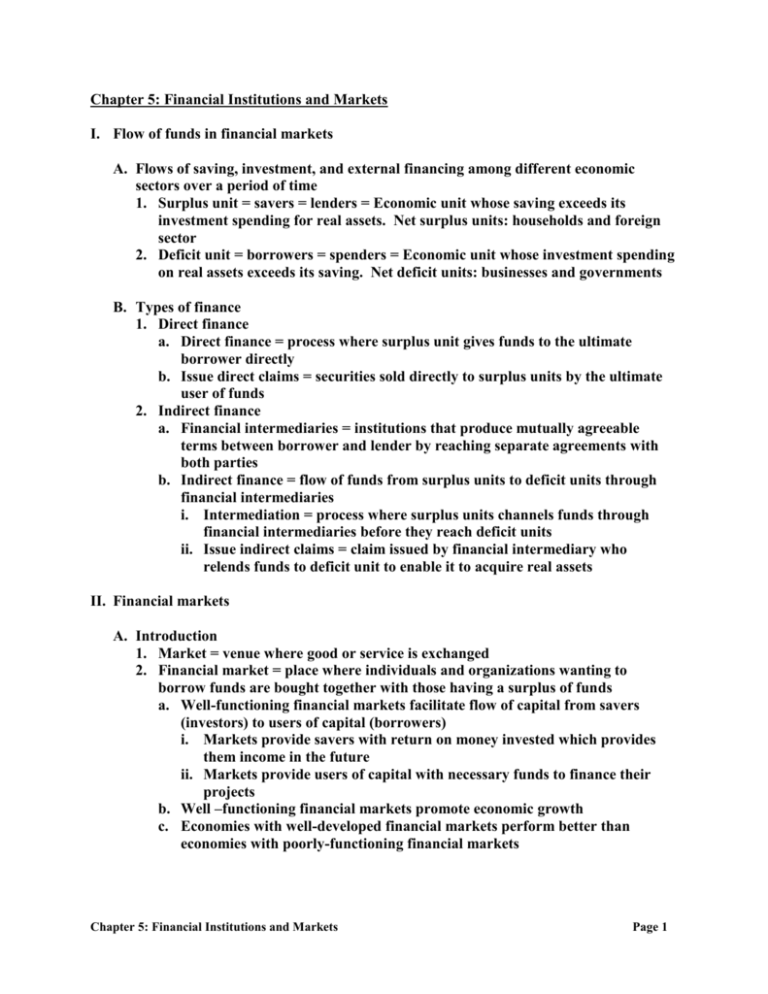
Chapter 5: Financial Institutions and Markets I. Flow of funds in financial markets A. Flows of saving, investment, and external financing among different economic sectors over a period of time 1. Surplus unit = savers = lenders = Economic unit whose saving exceeds its investment spending for real assets. Net surplus units: households and foreign sector 2. Deficit unit = borrowers = spenders = Economic unit whose investment spending on real assets exceeds its saving. Net deficit units: businesses and governments B. Types of finance 1. Direct finance a. Direct finance = process where surplus unit gives funds to the ultimate borrower directly b. Issue direct claims = securities sold directly to surplus units by the ultimate user of funds 2. Indirect finance a. Financial intermediaries = institutions that produce mutually agreeable terms between borrower and lender by reaching separate agreements with both parties b. Indirect finance = flow of funds from surplus units to deficit units through financial intermediaries i. Intermediation = process where surplus units channels funds through financial intermediaries before they reach deficit units ii. Issue indirect claims = claim issued by financial intermediary who relends funds to deficit unit to enable it to acquire real assets II. Financial markets A. Introduction 1. Market = venue where good or service is exchanged 2. Financial market = place where individuals and organizations wanting to borrow funds are bought together with those having a surplus of funds a. Well-functioning financial markets facilitate flow of capital from savers (investors) to users of capital (borrowers) i. Markets provide savers with return on money invested which provides them income in the future ii. Markets provide users of capital with necessary funds to finance their projects b. Well –functioning financial markets promote economic growth c. Economies with well-developed financial markets perform better than economies with poorly-functioning financial markets Chapter 5: Financial Institutions and Markets Page 1 B. Physical assets vs. financial assets 1. Physical assets a. = tangible assets. b. Ex: wheat, autos, real estate, computers and machinery 2. Financial markets a. Deal with stocks, bonds, notes, mortgages and other claims on real assets b. Derivative securities i. Securities whose values are derived from changes in the prices of other assets ii. Ex: options, futures iii. Can be used to hedge or reduce risk: An importer whose profit falls when the dollar depreciates could purchase currency future that do well when the dollar is weaker iv. Speculators use derivative market to forecast changes in future stock prices, interest rates, exchange rates and commodity prices. (1) Right guess will generate profits (2) Wrong guess results in large losses (3) Thus, derivatives increase risk C. Spot vs. futures markets 1. Spot market = market where assets are bough and sold for “on-the-spot” delivery, literally within days 2. Futures market a. Market where participants agree today to buy or sell an asset at some future date b. Agree upon future date, quantity and price D. Primary vs. secondary market 1. Primary market a. Def’n: a financial market in which securities are initially issued b. Market where issuer is directly involved in transaction c. First offering of stock to public = initial public offering (IPO). Any offering of stock by the firm after that point is a secondary offering. 2. Secondary market a. Def’n: financial market in which securities that are already owned (those that are not new issues) are traded. b. Market facilitates trade of existing securities from investor to investor c. Importance of secondary market i. Ensures liquidity of financial instruments such as bonds and stocks. (1) Note: Liquidity is relative ease and speed with which an asset can be converted into cash. (2) The most liquid asset? Cash. (3) More liquid the asset ==> greater demand ==> greater price ii. Secondary markets determine the price of the security that the issuing firm sells in the primary market Chapter 5: Financial Institutions and Markets Page 2 (1) Investors buying securities in primary market will pay issuing corporation no more than price they think secondary market will set for this security (2) The higher the price in the secondary market ==> the higher the price the issuing firm will receive for new security in primary market ==> hence the greater amount of financial capital issuing firm can raise E. Money Market vs. Capital Market 1. Money market a. Def’n: financial markets that facilitate flow of short-term funds with maturities of 1 year or less b. Money market securities = securities traded in money market 2. Capital market a. Def’n: financial markets that facilitate flow of long-term funds with maturities greater than 1 year b. Instruments traded in capital market are called securities. c. Examples of money market instruments: i. Bonds ii. Stocks III. Key types of securities A. Money market instruments: have high degree of liquidity 1. Treasury Bills = T-bills a. Short-term debt securities issued by U.S. Treasury b. Three different maturities: i. 13 weeks: sold in auction every Monday ii. 26 weeks: sold in auction every Monday iii. 1-year T-bills: auction occurs once a month c. Minimum par value = $10,000. Higher par value possible. d. T-Bills don’t pay explicit interest payments. T-Bills sold at a discount. Price of T-Bill < par value. e. interest = yield = percentage difference between price at which they are sold and price at which they were purchased f. Examples: Assume Company X buys 1-year T-Bill with par value of $100,000 and paid $94,000 for it. i. If Company X holds T-Bill till maturity, yield is 6.38%: $100,000-$94,000 i= ×100=6.38% $94,000 ii. If Company X holds T-Bill for two months, then sells it in secondary market for $95,000, annualized return = 6.47%. $95,000-$94,000 365 i= × =6.47% $94,000 60 g. Very liquid. Active secondary market. h. Treasury Bills have market risk, but not default risk 2. Commercial paper Chapter 5: Financial Institutions and Markets Page 3 3. 4. 5. 6. a. Short-term debt security issued by well-known firms with high credit ranking. b. Maturities typically between 20 and 45 days. Can be as long as 270 days. c. Does not pay explicit interest. Sold at discount. Interest determined by difference between selling and buying price. d. Poor secondary market. Less liquid than T-Bills. Typically held till maturity. e. Has both market and default risk. Low default risk. Negotiable Certificates of Deposit (NCD) a. Debt security issued by financial institutions to obtain short-term funds b. Common maturities: 10 days to 1 year. c. Pays explicit interest payments. d. Secondary market exists, but not as active as T-Bill secondary market. e. Have both market and default risk. Default risk depends on strength of issuing bank. Repurchase Agreements (repos) a. Repos are effectively short-term loans (usually with maturity of less than two weeks) in which Treasury Bills serve as collateral. b. Example: GM has $1 million of idle funds in checking account which it wants to lend for one week. Bank needs short-term monies to meet increased loan demand. GM uses excess $1 million to buy T-Bills from bank, which agrees to repurchase them next week at a price slightly above GM’s purchase price. Interest revenue = difference between selling and buying price. c. Important lenders in this market are large corporations Banker’s Acceptances = firm’s promise to pay, guaranteed by bank a. Created to carry out international trade and have been in use for hundreds of years b. Security is a bank draft (post-dated check, promise of future payment like a check) issued by firm, payable at future date, and guaranteed for a fee by bank that stamps it accepted. Low degree of risk if guaranteed by strong bank. c. Issuing firm places funds in account to cover draft; but, if firm fails to do so, guaranteeing bank obligated to make good on draft. d. Banker’s acceptances often sold in secondary market at discount. e. Maturity up to 180 days. Eurodollars a. Dollar denominated deposits in foreign banks outside the United States or in foreign branches of U.S. banks b. Short-term deposits that earn interest. Investors purchase Eurodollars for interest or tax advantages. c. American banks borrow Eurodollars. Important source of funds for American banks. d. Default risk depends on strength of using bank Chapter 5: Financial Institutions and Markets Page 4 7. Federal funds a. Reserves = bank’s vault cash and deposits at the Federal Reserve. Note: The Federal Reserve does not pay interest on reserves. Vault cash doesn’t earn interest. b. Required reserves = minimum percentage of deposits that banks cannot lend out and must hold as reserves. Why required reserves? i. Ensure bank liquidity ii. More importantly, helps determine the size of the money supply. c. Excess reserves = reserves – required reserves i. Excess reserves denote monies that banks can loan out ii. Opportunity cost of excess reserves = foregone interest iii. A profit-maximizing bank minimizes its holdings of excess reserves d. Federal funds are excess reserves that one bank loans to another bank often on an overnight basis. e. Cost of federal funds = federal funds rate = market interest rate determined by demand and supply of federal funds f. Federal funds rate: closely watched barometer of credit market. High federal funds rate implies banks strapped for funds. Federal funds rate is bank’s cost of acquiring funds. As federal funds rate increases (decreases), borrower’s interest cost of loan increases (decreases). 8. Consumer credit, including credit card debt a. Issued to individuals by banks, credit unions, finance companies b. Risk is variable as is the interest rate 9. Principal money market instruments: Amount Outstanding Amount Outstanding ($ billions, end of year) Type of Instrument 1980 1990 2000 2005 U.S. Treasury Bills 216 527 647 923 Certificates of Deposit 317 543 1053 1742 Commercial Paper 122 557 1619 1544 Banker’s Acceptances 42 52 8 4 Repurchase Agreements 57 144 366 518 Federal Funds 18 61 60 83 Eurodollars 55 92 195 438 B. Capital Market Instruments 1. U.S. Treasury Notes and Bonds a. Treasury notes have maturities between 1 year and 10 years b. Treasury bond maturities range between 10 and 30 years c. Minimum denomination: $1,000. Larger denominations more common. d. Active secondary market exist. Very liquid asset. e. Treasury notes and bonds pay explicit interest payments called coupon payments. Pay coupon payments semiannually (every six months). Ex: A $1,000,000 Treasury bond with an 8% coupon rate pays $80,000 in interest Chapter 5: Financial Institutions and Markets Page 5 each year: $40,000 after the first six-month period and another $40,000 after the second six-month period. f. Interest payments on U.S. Treasury are exempt from state and local income taxes. g. No default risk, only market risk. Return on U.S. Treasury bond referred to as long-term risk-free rate. Price will decline as interest rate increases. 2. Municipal bonds a. Issued by state and local governments. b. Pay interest on semiannual basis. Minimum denomination: $5,000. Larger denominations more common. c. Interest payments exempt from Federal income taxes. May even be exempt from state and local taxes. d. Have secondary market. Not as active as U.S. Treasury bond secondary market. e. Have both default and market risk. Riskier than U.S. government securities f. Municipal bonds classified into two different categories: i. General obligation bonds (1) Provide investors payments on interest and principal (2) Backed by municipality’s ability to tax ii. Revenue bonds (1) Provide investors payments on interest and principal (2) Uses funds generated by project financed with proceeds of bond sale 3. Corporate bonds a. Issued by corporations to finance investment in long-term assets such as buildings and equipment b. Standard denomination is $1,000 but other denominations issued. c. Maturities range between 10 and 30 years. Recent bond issues have had maturities of 50 years or more. Both Coca-Cola and Disney have recently issued bonds with 100 years of maturity. d. Pays coupon interest semiannually e. Secondary market exists, not as active as secondary market for U.S. government bonds f. International bonds: sell dollar denominated bonds in foreign country 4. Stocks a. Stocks don’t mature, but included in capital market because they behave long long-term asset b. Represent ownership interest in issuing firm c. Two types of stock i. Common stock (1) = units of ownership in firm. (2) Investors hope to earn return through dividend payments and capital gains. (3) Riskier than corporate bonds Chapter 5: Financial Institutions and Markets Page 6 5. 6. 7. 8. ii. Preferred stock (1) Special form of ownership that promises fixed periodic payment of dividend that must be paid before dividends paid to common stockholders. (2) Riskier than corporate bonds but less risky than common stock d. Both market risk and default risk. e. International stocks = U.S. investors may purchase international stocks and U.S. firms may sell stocks to international investors. f. Active secondary market Mortgages a. Loans to households and firms by commercial banks, credit unions, and savings and loans to purchase housing, land, or other real structures, where the structure and/or the land serves as collateral for loan b. Largest debt market in U.S. c. default risk d. Government ensures the liquidity of mortgages. Government agencies sell bonds, use funds to buy mortgages from financial institutions. If mortgages become more liquid, mortgage rates should decrease. i. Federal National Mortgage Association (FNMA = “Fannie Mae”). Stockholder owned charted by Congress. ii. Government National Mortgage Association (GNMA = “Ginnie Mae”) iii. Federal Home Loan Mortgage Corporation (FHLMC or “Freddie Mac”). Stockholder owned charted by Congress. Consumer and bank commercial loans a. Default risk b. Often no secondary market Leases a. Similar to debt in that firms can lease assets rather than borrow and then buy assets b. Risk similar to corporate bonds c. Leases run generally from 3 to 20 years and have returns similar to bond yields. Principal capital market instruments Amount Outstanding ($billions, end of year) Type of instrument 1980 1990 2000 2005 Corporate stocks Residential mortgages Corporate bonds $1,601 $4,146 $17,627 $17,853 1,106 2,886 5,463 9,436 366 1,008 2,230 2,983 1980 1990 2000 2005 U.S. government notes and bonds 407 1,653 2,184 2,803 U.S. government agency securities 193 435 1,616 2,696 Municipal bonds 310 870 1,192 1,807 Bank commercial loans 459 818 1,091 1,031 Consumer loans 355 813 536 710 Commercial and farm mortgages 352 829 1,214 1,919 Chapter 5: Financial Institutions and Markets Page 7 IV. Financial Institutions A. Financial institutions = financial intermediaries 1. Def’n: financial institutions are intermediaries that channel the savings of individuals, businesses, and government into loans and investments 2. Net suppliers of funds: individuals Net demanders of funds: businesses and governments 3. Type of financial intermediaries a. Depository institutions i. Commercial banks iii. Mutual savings banks ii. Savings and loans iv. Credit unions b. Contractual savings institutions i. Life insurance companies ii. Fire and casualty insurance companies iii. Pension funds, government retirement funds c. Investment intermediaries i. Finance companies iii. Money market mutual funds ii. Mutual funds B. Some basic accounting 1. Fundamental Accounting Identity Assets – Liabilities ≡ Net Worth Or Assets = Liabilities + Net Worth 2. Regarding financial institutions: a. liabilities = source of funds b. assets = use of funds C. Descriptions of major financial institutions Commercial bank Savings and loan Mutual savings bank Credit union Accepts demand (checking) and time (saving) deposits. Has monopoly right to offer demand deposits. Offers interest-earning savings account upon which checks can be written (NOW accounts). Offers money market deposit accounts. Makes loans directly to borrowers. Similar to commercial bank except it can’t offer demand deposits. Obtain funds from saving, NOW, and money market deposit accounts. Lends to individuals, businesses. Lends mortgages. Similar to savings and loan. Obtains funds through offering saving, NOW, and money market deposit accounts. Loans residential mortgages. Primarily transfers funds among consumers. Membership determined by common bond. Accepts saving, NOW, and money market deposit accounts. Assets include mortgages and consumer loans Chapter 5: Financial Institutions and Markets Page 8 Insurance companies Pension companies Mutual funds Securities firm Finance company Largest type of financial intermediary handling individual savings. Receives premiums. Invests premiums to cover future benefit payments. Lends to individuals, businesses, and government. Accumulates payments from employees and employers to provide for future retirement income. Monies invested in financial markets. Pools savings of small savers. Obtains funds through sale of shares and invests monies in bonds and stocks. Creates diversified portfolio to achieve specified investment objective. Money market mutual funds provide competitive returns with high degree of liquidity Provides investment banking services by helping firms acquire funds. Facilitates sale of existing securities Obtains funds by issuing securities. Lends funds to individuals and small businesses D. Other institutions 1. Investment banking houses a. Organizations that underwrites and distributes new investment securities and help businesses obtain financing b. Ex: Merrill Lynch, Morgan Stanley, Goldman Sachs, Credit Suisse Group c. Functions: i. Help corporations design securities attractive to investors ii. Buy these securities from corporations iii. Then resale securities to investors 2. Financial services corporations a. Firm that offers wide range of financial services including investment banking, brokerage operations, insurance and commercial banking b. Ex: Citigroup, American Express, Fidelity, Prudential E. Primary assets and liabilities of financial institutions Type of Financial Intermediary Depository Institutions Commercial banks Primary Assets (Uses of Funds) Primary Liabilities (Sources of Funds) Business & consumer loans, mortgages, U.S. government securities and municipal bonds Demand deposits, NOW accounts, time deposits, saving deposits, money market deposit accounts NOW accounts, time deposits, saving deposits, money market deposit accounts Savings and loan associations Chapter 5: Financial Institutions and Markets Mortgages Page 9 Type of Financial Intermediary Primary Assets (Uses of Funds) Mutual savings banks Mortgages Credit Unions Consumer loans Primary Liabilities (Sources of Funds) NOW accounts, time deposits, saving deposits, money market deposit accounts NOW accounts, time deposits, saving deposits, money market deposit accounts Contractual savings companies Life insurance companies Fire & Casualty Insurance co. Pension funds, government retirement funds Corporate bonds & mortgages Municipal bonds, corporate bonds and stock, U.S. government securities Policy premiums Policy premiums Employee and employer contributions Corporate stocks & bonds Investment Intermediaries Finance companies Consumer & business loans Mutual funds Money market mutual funds Stocks and bonds Money market instruments Commercial paper, stocks, bonds Shares Shares F. Assets of principal financial intermediaries Type of Financial Intermediary Depository Institutions Commercial banks Savings and loan associations and mutual savings banks Credit unions Contractual savings institutions Life insurance companies Fire & Casualty Insurance Cos. Pension funds (private) State & local government retirement funds Chapter 5: Financial Institutions and Markets Value of Assets ($ billion, at end of year) 1980 1990 2000 2005 $1,481 $3,334 $6,469 $9,156 792 1,365 1,218 1,750 67 215 441 688 464 182 504 197 1,367 533 1,629 737 3,136 862 4,355 2,293 4,351 1,242 4,527 2,661 Page 10 Type of Financial Intermediary Investment Intermediaries Finance companies Mutual funds Money market mutual funds Value of Assets ($ billion, at end of year) 1980 1990 2000 2005 205 70 76 610 654 498 1,140 4,435 1,812 1,439 5,882 1,877 V. Major security exchanges A. Security exchanges 1. Def’n: Organizations that provide the marketplace in which firms can raise funds through sale of new securities and in which purchasers can resale securities 2. Types of exchanges a. Physical location exchanges = tangible organizations that act as secondary markets where outstanding securities are sold. Ex: New York Stock Exchange (NYSE) b. Electronic dealer based markets = over-the-counter = an intangible market (not one sole tangible location) for the purchase and sale of securities not listed by the organized exchanges B. Physical location stock exchanges 1. New York Stock Exchange (NYSE) a. Accounts for 90% of total annual dollar volume of shares trade on all organized exchanges b. To trade on “floor” of NYSE, need a “seat”. 1,366 seats on NYSE floor, most owned by large brokerage firms. In 2005 seat sold for $1 million < record high price of $2.65 million c. To have one’s stock listed on NYSE, a firm must have at least: i. 2,000 stockholders, each owning 100 shares or more ii. A minimum of 1.1 million shares of publicly held stock iii. Demonstrated earning power of $2.5 million before taxes at time of listing and $2 million before taxes for each of the preceding 2 years iv. Net tangible assets of $18 million v. Publicly trade shares must have market value of $18 million d. Trading carried out through auction process i. Goal: to give both purchasers and buyers of stock best possible deal ii. Fills buy orders (orders to purchase stocks) at lowest price iii. fills sell orders (orders to sell securities) at highest possible price 2. American Stock Exchange (AMEX) a. Located in New York City Chapter 5: Financial Institutions and Markets Page 11 b. Was owned by the NASDAQ (see below) market between 1998 and 2005. AMEX bought exchange back from NASDAQ in 2005 because merger wasn’t successful c. Trading also conducted on trading floor. Smaller volume than NYSE. C. Over-the-Counter (OTC) Exchange 1. Market price of OTC securities determined by demand and supply for securities by traders known as dealers 2. NASDAQ market = National Association of Securities Dealers Automated Quotation: uses sophisticated telecommunications network to link dealers with purchasers and sellers of securities 3. Bid price = highest price offered by dealer to purchase given security. Ask price = lowest price at which dealer willing to sell security. Dealer buys and sells securities. Dealer adds to and depletes his or her inventory of stock. Dealer hopes to profit from the spread between the bid and ask prices 4. While OTC market creates a secondary market for outstanding securities, it is also a primary market in which all new public issues are sold VI. Market for common stock A. Types of corporations 1. Closely held corporation = corporation owned by few individuals who are typically associated with firm’s management 2. Publicly owned corporation = corporation that is owned by relatively large number of individuals who are not actively involved in its management 3. Recent study shows 46% of all common stock owned by institutional investors. These institutions buy and sell relatively actively and account for 75% of all transactions. a. 26% held by pension funds d. 3% held by insurance companies b. 10% held by mutual funds e. 1% held by brokerage firms c. 6% held by foreign investors B. Types of stock market transactions 1. Trading in the outstanding shares of established, publicly owned companies: the secondary market 2. Additional shares sold by established, publicly owned companies: the primary market 3. Initial shares sold by established, privately owned companies a. The initial public offering (IPO) market = market for stocks for companies in the process of going public b. Going public = act of selling stock to public by a closely held corporation or its principal stockholders C. Stock market efficiency 1. Efficient markets hypothesis a. Hypothesis that securities are typically in equilibrium Chapter 5: Financial Institutions and Markets Page 12 2. 3. 4. 5. b. Implies that securities are fairly priced and the price reflects all publicly available information on each security Three levels of market efficiency a. Weak-form efficiency: i. Information contained in past stock price movements are fully reflected in current market prices ii. Information about recent trends in stock prices would be no use in selecting stocks iii. Weak-form efficiency implies that any information that comes from an examination of past stock prices cannot be used to make money by predicting future stock prices b. Semistrong-form efficiency i. Current market prices reflect all publicly available information ii. Market prices adjust to any good or bad news contained in information as soon as it became available iii. Investors should not earn above-average returns except with good luck or information that is not publicly available iv. Whenever information is released to the public stock prices will respond only if information is different from what had been expected c. Strong-form efficiency i. Assumes current stock prices reflect all pertinent information, whether publicly available or privately held ii. Implies that even insiders would find it impossible to earn abnormally high returns in the stock market Empirical studies suggest stock market is indeed highly efficient in the weak form, reasonably efficient in the semistrong form but market is not efficient in the strong form Implications of market efficiency: If stock prices already reflect all publicly available information → stocks are fairly priced → can “beat the market” only by luck or with inside trading → making it almost impossible to consistently outperform the market averages Attack on efficient market theory: behavioral finance a. Area of finance that incorporates elements of cognitive psychology into finance in an effort to better understand how individuals and entire markets respond to different circumstances b. Skeptics of efficient markets point to recent stock market bubbles and the height of the boom → prices were significantly above intrinsic value → suggest individuals are not simply machines processing information. Rather a variety of psychological and perhaps irrational factors come in play Chapter 5: Financial Institutions and Markets Page 13
